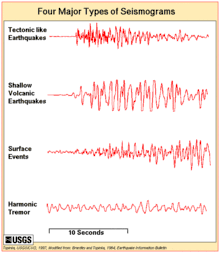Harmonic tremor
A harmonic tremor is a sustained release of seismic and infrasonic energy typically associated with the underground movement of magma, the venting of volcanic gases from magma, or both. It is a long-duration release of seismic energy, with distinct spectral lines, that often precedes or accompanies a volcanic eruption. More generally, a volcanic tremor is a sustained signal that may or may not possess these harmonic spectral features. Being a long-duration continuous signal from a temporally extended source, a volcanic tremor contrasts distinctly with transient sources of seismic radiation, such as tremors that are typically associated with earthquakes and explosions.


The relation between long-period events and an imminent eruption was first observed by Bernard Chouet, a volcanologist who was working at the United States Geological Survey.[1][2][3]
Notes
- Chouet, Bernard A. (1996). "Long-period volcano seismicity: its source and use in eruption forecasting". Nature. 380 (6572): 309–316. Bibcode:1996Natur.380..309C. doi:10.1038/380309a0. ISSN 0028-0836.
- Interview with Bernard Chouet regarding his research into long-period events and volcanic eruptions: http://www.esi-topics.com/volcanoes/interviews/BernardChouet.html Archived 2009-02-01 at the Wayback Machine .
- U.S. TV program on use of long-period events to predict volcanic eruptions: "Nova: Volcano's Deadly Warning": https://www.pbs.org/wgbh/nova/volcano/ . See also "Volcano Hell" episode of BBC TV series "Horizon" on same subject: http://www.bbc.co.uk/science/horizon/2001/volcanohell.shtml .